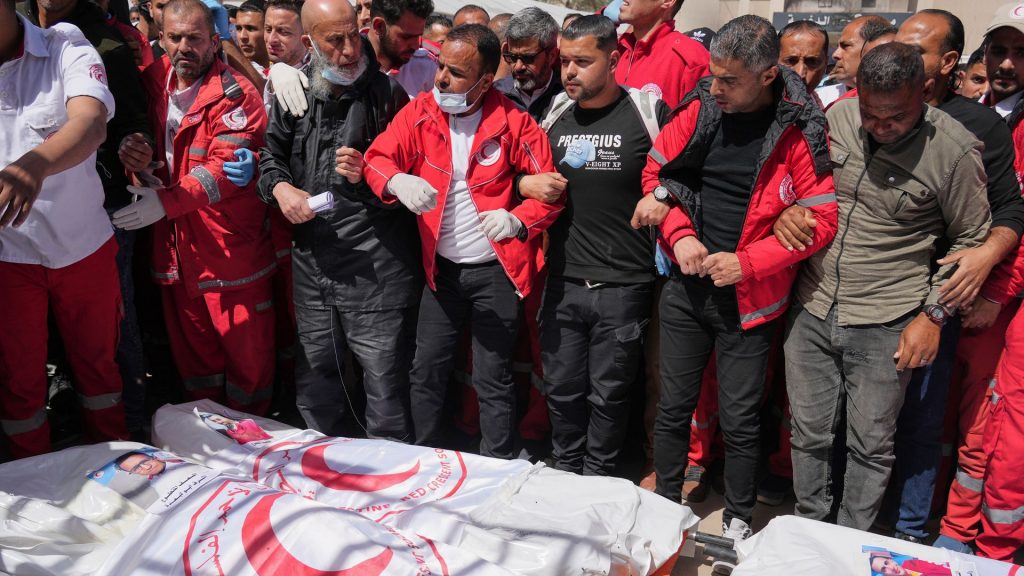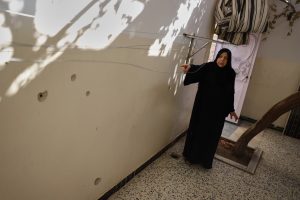How ‘professional failures’ led to the killing of 15 medics in Gaza
Ella Greene April 20, 2025 0
- The Israeli government released the findings of its investigation into the killings of 15 Gaza first responders last month and concluded that their deaths were the result of “professional failures.” The deputy commander who oversaw the IDF troops involved in the assault has been fired.
- After the IDF killed the 15 first responders, their bodies were bulldozed into a mass grave, making way for an evacuation route that would open roughly a week later out of the southern Gaza city of Rafah.
- Israel’s Military Advocate General now has the findings and will decide whether criminal charges should be pursued, though such action from the independent body is rare.
Full Story
The Israeli government on Sunday, April 20, released the findings of its investigation into the killings of 15 Gaza first responders last month, and concluded that their deaths were the result of “professional failures.” The government added that the deputy commander who oversaw the assault will be fired, marking one of the first such disciplinary actions in the 18-month war between Israel and Hamas.
What prompted Israel’s investigation?
In the dawn hours of March 23, Israel Defense Forces (IDF) troops opened fire on several ambulances as they responded to another ambulance that had previously come under fire. The first responders included eight paramedics with the Palestinian Red Crescent Society, six workers from the Civil Defense and a U.N. staffer.
Initially, the Israeli government claimed that its soldiers fired upon the medics’ vehicles because they were driving suspiciously and without any emergency signals. However, cellphone video recovered from the scene contradicted that account, prompting Israel to walk back its claims and launch an investigation.
In its investigation, Israel shifted its stance, saying that the deputy battalion commander believed the ambulances belonged to Hamas militants “due to poor night visibility.” The cellphone video, however, shows that the ambulances had flashing lights and their logos were clearly visible. Likewise, the Associated Press notes that the “teams do not appear to be acting unusually or in a threatening manner.”
Why were the bodies bulldozed into a mass grave?
Following five minutes of heavy gunfire that killed the 15 first responders, IDF troops bulldozed the bodies, along with their flattened vehicles, into an unmarked mass grave. This, the investigation said, was wrong, but added “there was no attempt to hide the incident.”
The assault took place in Tel al-Sultan, a district in the southern Gaza city of Rafah, which was placed under evacuation orders roughly a week later, on March 31. The bodies and vehicles were reportedly bulldozed to make way for that evacuation route.
Israel’s findings contradict other accounts
The Israeli investigation claims that six of the people killed in the ambulances were Hamas militants. However, the government hasn’t provided their names, nor any other evidence to support the assertion. Likewise, none of the first responders were armed, and no weapons were found in their vehicles, Maj. Gen Yoav Har-Even, leader of the Israeli military’s investigative branch, said.
Israel has long contended that Hamas uses ambulances and other civilian infrastructure to hide its combatants.
The investigation also seeks to rebuke findings from the head of the Palestinian Red Crescent Society and a U.N. official, both of whom said the first responders were killed “one by one” and that they were “targeted at close range.” Israel’s military said it found “no evidence to support claims of execution or that any of the deceased were bound before or after the shooting.” While some witnesses and relatives of the deceased allege that at least one person had their hands bound, a forensic pathologist in Gaza who conducted the postmortems said he had detected no visible signs of restraint.
Meanwhile, about 15 minutes after the ambulances were ambushed –– something the investigation called an “operational misunderstanding” –– IDF soldiers similarly fired upon a Palestinian U.N. vehicle, which amounts to a breach of orders, according to the military investigation. One person was killed in that assault.
Israel fires a deputy commander
The deputy commander who oversaw the IDF soldiers and was the first to fire upon the vehicles will be dismissed for failing to give a “completely accurate” report to investigators about the U.N. vehicle incident, Har-Even said. The disciplinary action marks one of the most severe punishments doled out by Israel since the start of the war.
In conclusion, the report states that Israel’s military “regrets the harm caused to uninvolved civilians.”
What happens next?
Israel’s Military Advocate General (MAG), an independent body overseen by the country’s attorney general and Supreme Court, now has the findings and will decide whether criminal charges should be pursued. However, of the 421 incidents that the MAG is currently investigating, as well as the 51 investigations it has closed, it is unclear how many times criminal charges have arisen, or how many cases involve potential wrongful deaths.
The U.N. notes that since the start of the war, 150 emergency responders from the Red Crescent and Civil Defense, as well as more than 1,000 health workers, have been killed in Israeli strikes.
Related Stories
Ella Rae Greene, Editor In Chief
Ella Greene
Ella and the staff at Clear Media Project (CMP) curate these articles.
Unless otherwise noted CMP does not write these articles.
The views, thoughts, and opinions expressed in the articles published on this blog belong solely to the original authors and do not necessarily reflect the views of the blog owner. The blog owner does not claim ownership of the content shared by contributors and is not responsible for any inaccuracies, errors, or omissions.
All rights and credits goes to its rightful owners. No Copyright Infringement is intended. If you believe any content infringes on your rights, please contact us for review and potential removal.





